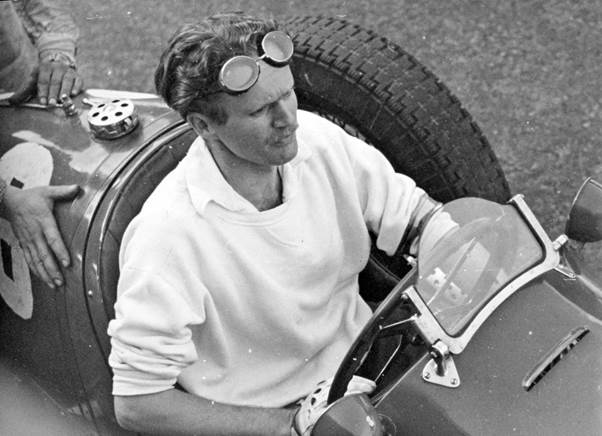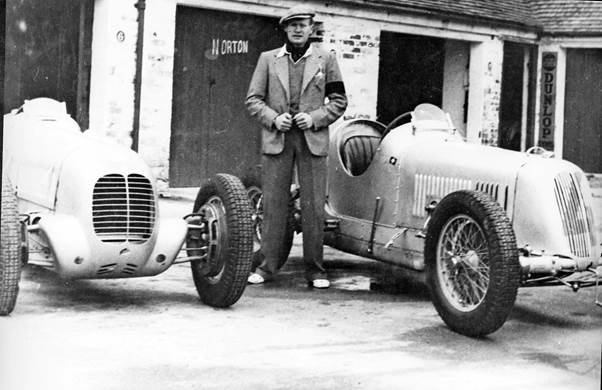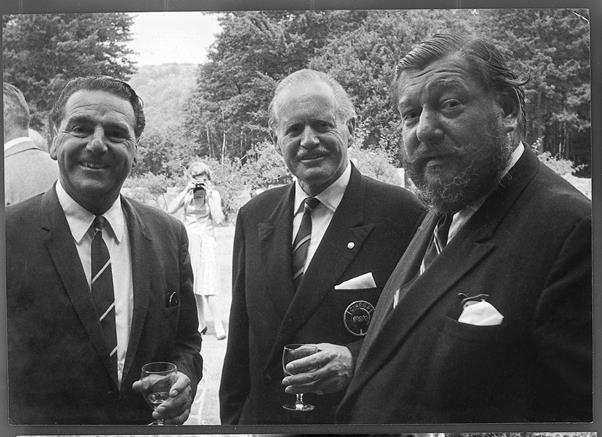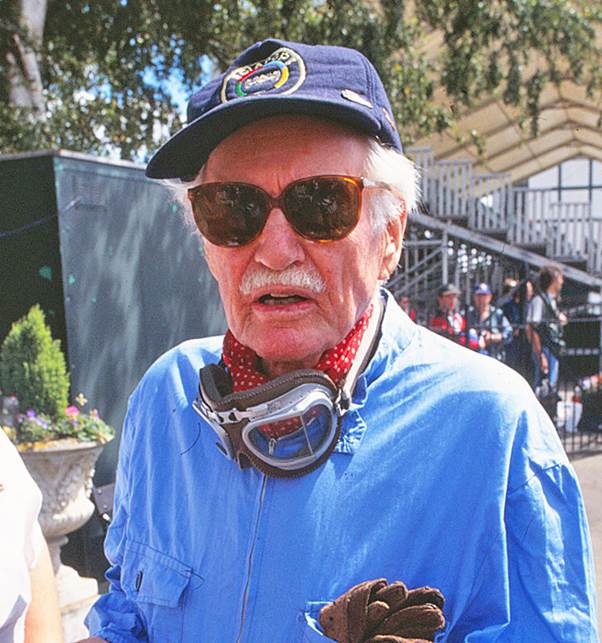
Like everyone of my generation, it was necessary to serve for two years in one of the armed services, National Service. In my case, I was fortunate to be taken up by the Royal Air Force and during early training, I was based at Compton Bassett in Wiltshire. Whilst there I felt the need to keep up to date with my motor racing as I had written about racing before being put into the RAF. I noted that in May 1953 the Daily Express Trophy meeting was due to take place at Silverstone and I was due some time off so the plan was to go and watch the race. I had applied for my press credentials as usual but the trouble was how to get from an outlying RAF camp in Wiltshire to Silverstone when I had no car to drive and hardly a clue as to which direction to take save that it was north. Looking back now I should have contacted another young National Serviceman on the camp, Tommy Bridger, who not only had permission to have his MG TC on the camp but had also started racing a 500cc Formula 3 Cooper. ( Bridger was later to compete in Formula 2 and saloons before being selected by Ken Gregory to race for his BRP team in the Moroccan Grand Prix with a Cooper).
My plan, therefore, was to hitch-hike from Compton Bassett to Silverstone. It was a disaster as I started out at about 5.pm and by 10 pm I had only reached Swindon fifteen miles away! It was cold and damp and never got to Silverstone to see Emanuel “Tuolo” de Graffenried in his Maserati A6GCM win the International Trophy.
Tuolo de Graffenried was a very popular competitor in racing who always seemed to have a smile on his face and even after he retired from racing he was to be President and one of the founders of the Club des Anciennes Pilotes de Formula 1. He was one of Maserati’s most loyal customers
Though he was always entered as a Swiss and ran with the Swiss flag on his cars Emanuel de Graffenried was actually born in Paris in 1914. He was of Noble stock and his family can be traced back to the 12th century based in the village of Grafenried (Note, one “F”) northeast of Berne.
One of his ancestors, Baron Christopher de Graffenried, who sailed to the United States seeking his fortune in silver mining, is credited with establishing the first colony in North Carolina in a town he named New Bern in Craven County. Through the centuries the de Graffenried’s multiplied and were scattered around the world, many of them in diplomatic roles. Emanuel’s father was a cavalry officer and it appeared as though Emanuel would be destined for a similar career but this was not in his game plan. For him, engines and wheels were the directions he took. His first vehicle was an AJS motorcycle that he rode at the age of 12. He was well educated including three years at the elite school “Le Rosey” in Rolle, near Geneva. It was here that was given the nickname “Tuolo” which stuck with him for the rest of his life. One of his classmates at Le Rosey was a young Iranian by the name of Reza Pahlevi, the future, and last, Shah of Persia. However, his great school friend was an American called John du Puy whose family had emigrated to the United States in the 1700s. De Puy was also a racing enthusiasts
De Graffenried’s first pure racing car was an Alfa Romeo 6C 1500 Sport he bought in 1936 from Giacomo de Rham. His firsts race was the Mille Miglia that year where he raced against the car’s previous owner, de Rham who was out in his brand new 8C 2300 Alfa. It was an eventful race for de Graffenried who clearly was not used to the powerful Alfa for not far from the start in Brescia he and his mechanic Arzilla misjudged a corner and hit a bridge. After a cursory inspection, they carried on but around 300 miles later they had to retire the car.
When interviewed by journalist Adriano Cimarosti, de Graffenried recalled that same year travelling all the way to Cluje in Romania for a hill climb. He took with him another racing friend, Ciro Basadonna who was to become a private entrant with various Maseratis and also was co-driver to Louis Chiron when he won the 1954 Monte Carlo Rally in a Lancia GT and co-driver to Luigi Villoresi in the 1958 Acropolis rally also in a Lancia.
“ In Romania, we were welcomed with all the honours. Even King Carol of Romania attended the hill climb: these were different times. The trip took Ciro and I three days to get to Cluje and in one Hungarian village we were welcomed like heroes as they had never seen those strange racing cars before”

As has been mentioned, de Graffenried had many titled friends and at the Swiss hill climb at Les Rangiers de Graffenried let a Polish student share the driving of his car. He was Prince Stanislaw Radziwill who married the sister of John F and Bobby Kennedy.
After a year with the Alfa Romeo sports car, de Graffenried decided to move up to single-seaters for 1937 and with his friend John du Puy they formed the Swiss American Racing Team. De Graffenried bought Maserati 4CM chassis 1528 that had originally been bought by Ippolito Berrone but was then owned by one of the most colourful racing drivers of the period, Tasmanian born Frank McEvoy. McEvoy was a playboy based in the South of France who had a reputation as a collector of rich lady friends and gambling. Apparently he bought the 4CM after winning a lot of money playing baccarat in Monte Carlo. His best result was sixth place in the 1936 Vanderbilt Cup.
Now de Graffenried owned the car and entered it under his own name for the Coppa Principessa di Piemonte on the Posillipo circuit outside Naples. He did well to finish sixth in the race only a lap behind the winner, Count Trossi. Meanwhile, John Du Puy bought a Maserati 6CM (1535). This car was also owned by Frank McEvoy who had bought it new from the factory the previous year. The likelihood is that the pair bought both cars from McEvoy at the same time and they first ran them together on the Isle of Man in the RAC Light Car Race in June 1937. Once more de Graffenried finished sixth and he was clearly the quicker of the two drivers. The pair raced a number of times that season with their silver-painted Maseratis but clearly John du Puy’s heart was not in it and he retired from racing but continued to go to the races with his friend Emmanuel de Graffenried.
The 4CM was raced in the 1938 season but clearly, de Graffenried wanted to get into grand prix racing in 1939 but there were few racing cars around and so the team bought a five-year-old Maserati 6C 34 which had its 3.7-litre six-cylinder engined reduced to 3 litres by chief mechanic Neri. The car was originally owned by the Subalpina team and was chassis 3025 raced by Piero Dusio later to become more famous as the creator of the Cisitalia. However, the car proved to be difficult to drive but de Graffenried did win a relatively unimportant race at Berne with it.

When World War II came along Emmanuel de Graffenried joined the Swiss army in the motorised division but he still longed to get back to motor racing. It was no surprise therefore when, in 1946, he and his friend Ciro Basaddona he formed Ecurie Autosport with de Graffenried in the 6CM and Basadonna in a 4CL and both entered for the Grand Prix of Marseilles where de Graffenried took third place in the second heat and fifth overall in the final, a remarkable effort. However, at this race, Emmanuel de Graffenried became friendly with another competitor, Enrico Plate – later to produce the Maserati Plate’s. As de Graffenried recalled: “ We decided to race together and so at the Grand Prix des Nations in Geneva I raced his 4CL. Finally, I was driving a real car properly prepared”. His performance in Heat 2 saw him finish fourth behind Farina, Trossi and Nuvolari and he took fifth place in the final.
“ Enrico Plate was a kind and generous man; we raced together for eight years, up to early 1954, when he died at the Grand Prix of Buenos Aires. With Enrico Plate, there was no need to sign a contract for the following year. His word was enough. He was a technician with great intuition, an untiring worker, always cordial and ready to help others”.
Another man to join the Scuderia Plate team was Prince Bira and he and de Graffenried raced a total of three 4cls, (1584,1585 and 1587). Though de Graffenried was not in the top echelon of grand prix drivers of that era he was a regular competitor all through the 1950s. In his interview with Adriano Cimarosti, he admitted: “ Those were great times. On the Plate team, we were a real family. One for all and all for one. The Maseratis were transported on an old Dodge truck, once issued to the American army in Europe. When the mechanics would drop from fatigue I would take over the wheel of the big truck. Once at night, my wife Elsa crossed the Belgian border without even realising it, arriving at Spa without the necessary customs stamps. We bummed around Europe from one track to another. Sponsors did not exist. Only fuel, oil and tyres were free. A few weeks before a race the organiser negotiated with the drivers and we were offered on average 3000 Swiss francs per car which was not very much in those days. The racing environment was different, even the drivers formed a family, stayed in the same hotels, ate together and jokes amongst friends were a part of daily life”.
Silverstone always had bitter-sweet memories for de Graffenried. For a start he won the pre-World Championship British Grand Prix in 1949 in a 4CLT Maserati, Four years later, at the BRDC International Trophy race I tried to get to in 1953, he was very impressive not only being on pole position for the first heat but winning the race ahead of Stirling Moss’s Cooper-Alta and Bira’s Maserati. In the second heat Mike Hawthorn was the winner in a factory Ferrari 500 and so for the final Hawthorn and de Graffenried shared the front row of the grid with Ken Wharton ( Cooper-Bristol) and Stirling Moss. As the cars lined up for the start the timekeeper was counting off the seconds behind the starter with his flag. However, the starter moved and de Graffenried dropped the clutch only to immediately brake letting the other front-row drivers pass him. However, he got his head down and took the lead at the end of the first lap and was leading Hawthorn when, after deliberation, the Stewards decided de Graffenried should be penalised one minute for a jump start. Enrico Plate was furious and after sixteen laps with de Graffenried now in second place, ordered the Swiss to retire from the race in protest. He was credited alongside Mike Hawthorn with the fastest lap of the race but it was a bitter disappointment for this most gentlemanly driver.
In the Grand Prix of Argentina of 1954 de Graffenried had one of the 2.5 litre Maserati engines in his A6GCM making it one of the interim models that was to eventually become the 250F.’ A week later there was a non-championship Formula Libre event which would allow a lot of the local drivers to compete against the grand prix cars and again Enrico Plate entered de Graffenried in the A6GCM but it was to end up with tragedy. The Maserati had to retire from the race and de Graffenried brought it into the pits and then nipped next door to have a shower before changing. He heard some noise and commotion outside and was horrified to find that Jorge Daponte who was racing his Maserati A6GCM had lost control of his car which veered across the road and into the pit lane where Enrico Plate was standing and he was killed on the spot. For de Graffenried. “ Enrico’s death deeply upset me. I returned home heartbroken and for me, it was also an omen, an inducement to stop racing”.
Though he had technically retired de Graffenried did appear on circuits. For example that same year he was asked to help out 20th Century Fox on a motor racing film they were making called “The Racers” loosely based on a book of fiction by real-life grand prix driver Hans Ruesch. Kirk Douglas took the leading role and de Graffenried was responsible for preparing one or two older Maseratis to be dressed up as “Buranos” and he actually drove one of them in the Belgian Grand Prix with a camera mounted on the front to get realistic footage. After the film de Graffenried sold off the cars which were returned to their correct Maserati shape. Finally, in 1956 Mimo Dei of Scuderia Centro Sud offered de Graffenried one of his 250F Maseratis for the Italian Grand Prix. The car was chassis 2511 and was already two years old and yet he managed to finish eighth: it was his last race.

Meanwhile, de Graffenried had secured an agency for Alfa Romeos and after his work on the movie, he was called in to advise on other promotions and presentations. When Louis Chiron died he was then made President of the Club des Anciennes Pilots de Formula 1. At the same time, he had become Marlboro’s ambassador and was instrumental in many of the sponsorship arrangements by Marlboro in motorsport.
In a sport that attracted people from all walks of life and with different temperaments, Emmanuel de Graffenried was a true gentleman racing driver. As mentioned, he was not of the highest rank but was still given factory drives by both Alfa Romeo and Maserati. He was always a cheerful character with a smile and a wiggle of his white moustache. He died on January 22, 2007, at the age of 92.
